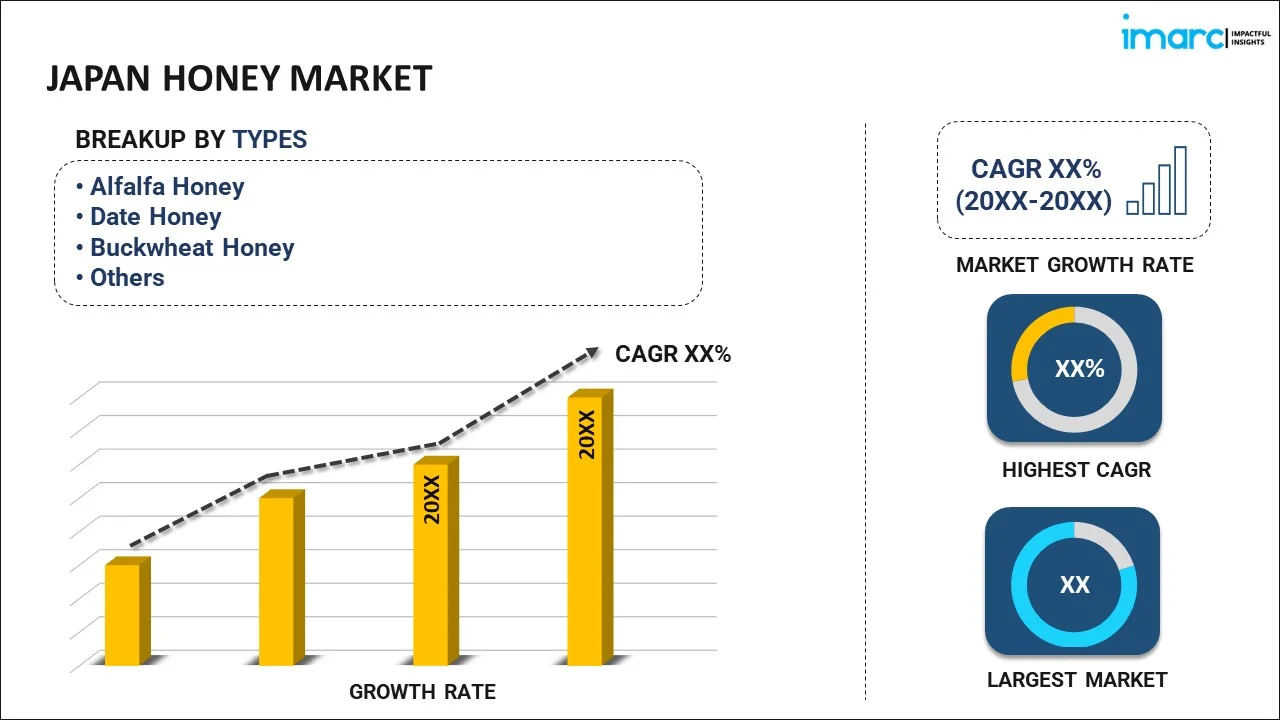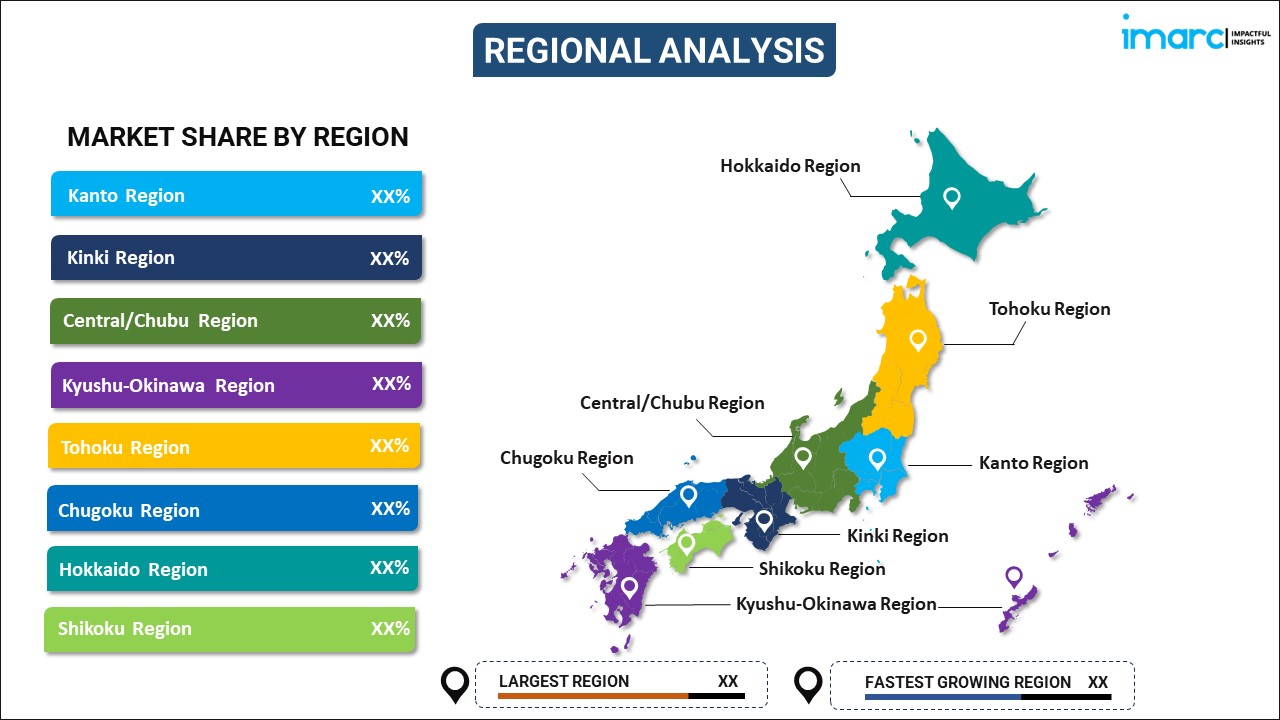
Japan Honey Market Report by Type (Alfalfa Honey, Date Honey, Buckwheat Honey, Acacia Honey, Clover Honey, Linden Honey, and Others), Application (Food and Beverages, Personal Care and Cosmetics, Pharmaceutical, and Others), Distribution Channel (Supermarkets and Hypermarkets, Convenience Stores, Online Stores, and Others), and Region 2025-2033
Market Overview:
The Japan honey market size is projected to exhibit a growth rate (CAGR) of 4.10% during 2025-2033. The growing demand in various skincare products to provide moisture to the skin, wide availability through various distribution channels, and rising utilization in various beverages, such as tea, coffee, and cocktails, represent some of the key factors driving the market.
|
Report Attribute
|
Key Statistics
|
|---|---|
|
Base Year
|
2024
|
|
Forecast Years
|
2025-2033
|
|
Historical Years
|
2019-2024
|
| Market Growth Rate 2025-2033 | 4.10% |
Honey is a naturally sweet product that is produced by honeybees through a process of collecting nectar from flowers and other floral sources, such as cherry blossoms, buckwheat flowers, and citrus blossoms. It has a rich and thick texture, distinct flavors, high quality, and aromatic taste. It is a rich source of antioxidants, vitamins, minerals, and enzymes that can support overall well-being. It is cost-effective, versatile, and has a long shelf life and antibacterial, anti-inflammatory, and wound-healing properties. It assists in soothing sore throats and relieving coughs while providing relief from irritation. It aids in promoting tissue repair and can be applied topically to minor cuts, burns, and wounds to support the healing process and prevent infection. It also reduces oxidative stress, supports overall cellular health, and neutralizes harmful free radicals in the body. Besides this, it is beneficial in boosting the immune system and strengthening the defense mechanism of the body against infections and diseases. As it relieves constipation and soothes digestive discomfort among individuals, the demand for honey is rising in Japan.
Japan Honey Market Trends:
At present, the rising consumption of honey in various beverages, such as tea, coffee, and cocktails, represents one of the major factors supporting the growth of the market in Japan. Besides this, the increasing utilization of honey in the pharmaceutical industry for the manufacturing of cough syrups is strengthening the growth of the market in the country. Additionally, there is a rise in the demand for high quality and cost-effective honey among the masses in Japan. This, coupled with the increasing employment of honey in baking products, such as cakes and cookies, is bolstering the growth of the market. Apart from this, the growing demand for honey due to the increasing number of health-conscious consumers is positively influencing the market in the country. In addition, the wide availability of honey through various distribution channels, such as supermarkets, hypermarkets, and convenience and online stores in Japan, is contributing to the growth of the market. Moreover, the increasing adoption of honey as a food preservative due to its enhanced shelf life is offering lucrative growth opportunities to industry investors in the country. In line with this, the growing demand for honey in numerous skincare products, as it aids in moisturizing and nourishing the skin while preventing acne, is offering a positive market outlook in Japan. Furthermore, the increasing consumer preferences for natural sweeteners in food products that do not harm the body is impelling the growth of the market in the country.
Japan Honey Market Segmentation:
IMARC Group provides an analysis of the key trends in each segment of the Japan honey market report, along with forecasts at the country level for 2025-2033. Our report has categorized the market based on type, application, and distribution channel.
Type Insights:

- Alfalfa Honey
- Date Honey
- Buckwheat Honey
- Acacia Honey
- Clover Honey
- Linden Honey
- Others
The report has provided a detailed breakup and analysis of the market based on the type. This includes alfalfa honey, date honey, buckwheat honey, acacia honey, clover honey, linden honey, and others.
Application Insights:
- Food and Beverages
- Personal Care and Cosmetics
- Pharmaceutical
- Others
A detailed breakup and analysis of the market based on the application has also been provided in the report. This includes food and beverages, personal care and cosmetics, pharmaceutical, and others.
Distribution Channel Insights:
- Supermarkets and Hypermarkets
- Convenience Stores
- Online Stores
- Others
A detailed breakup and analysis of the market based on the distribution channel has also been provided in the report. This includes supermarkets and hypermarkets, convenience stores, online stores, and others.
Regional Insights:

- Kanto Region
- Kinki Region
- Central/ Chubu Region
- Kyushu-Okinawa Region
- Tohoku Region
- Chugoku Region
- Hokkaido Region
- Shikoku Region
The report has also provided a comprehensive analysis of all the major regional markets, which include Kanto Region, Kinki Region, Central or Chubu Region, Kyushu-Okinawa Region, Tohoku Region, Chugoku Region, Hokkaido Region, and Shikoku Region.
Competitive Landscape:
The report has also provided a comprehensive analysis of the competitive landscape in the Japan honey market. Competitive analysis such as market structure, key player positioning, top winning strategies, competitive dashboard, and company evaluation quadrant has been covered in the report. Also, detailed profiles of all major companies have been provided.
Report Coverage:
| Report Features | Details |
|---|---|
| Base Year of the Analysis | 2024 |
| Historical Period | 2019-2024 |
| Forecast Period | 2025-2033 |
| Units | Million USD |
| Scope of the Report | Exploration of Historical and Forecast Trends, Industry Catalysts and Challenges, Segment-Wise Historical and Predictive Market Assessment:
|
| Types Covered | Alfalfa Honey, Date Honey, Buckwheat Honey, Acacia Honey, Clover Honey, Linden Honey, Others |
| Applications Covered | Food and Beverages, Personal Care and Cosmetics, Pharmaceutical, Others |
| Distribution Channels Covered | Supermarkets and Hypermarkets, Convenience Stores, Online Stores, Others |
| Regions Covered | Kanto Region, Kinki Region, Central/ Chubu Region, Kyushu-Okinawa Region, Tohoku Region, Chugoku Region, Hokkaido Region, Shikoku Region |
| Customization Scope | 10% Free Customization |
| Post-Sale Analyst Support | 10-12 Weeks |
| Delivery Format | PDF and Excel through Email (We can also provide the editable version of the report in PPT/Word format on special request) |
Key Questions Answered in This Report:
- How has the Japan honey market performed so far and how will it perform in the coming years?
- What has been the impact of COVID-19 on the Japan honey market?
- What is the breakup of the Japan honey market on the basis of type?
- What is the breakup of the Japan honey market on the basis of application?
- What is the breakup of the Japan honey market on the basis of distribution channel?
- What are the various stages in the value chain of the Japan honey market?
- What are the key driving factors and challenges in the Japan honey market?
- What is the structure of the Japan honey market and who are the key players?
- What is the degree of competition in the Japan honey market?
Key Benefits for Stakeholders:
- IMARC’s report offers a comprehensive quantitative analysis of various market segments, historical and current market trends, market forecasts, and dynamics of the Japan honey market from 2019-2033.
- The research study provides the latest information on the market drivers, challenges, and opportunities in the Japan honey market.
- Porter's five forces analysis assist stakeholders in assessing the impact of new entrants, competitive rivalry, supplier power, buyer power, and the threat of substitution. It helps stakeholders to analyze the level of competition within the Japan honey industry and its attractiveness.
- Competitive landscape allows stakeholders to understand their competitive environment and provides an insight into the current positions of key players in the market.
Need more help?
- Speak to our experienced analysts for insights on the current market scenarios.
- Include additional segments and countries to customize the report as per your requirement.
- Gain an unparalleled competitive advantage in your domain by understanding how to utilize the report and positively impacting your operations and revenue.
- For further assistance, please connect with our analysts.
 Inquire Before Buying
Inquire Before Buying
 Speak to an Analyst
Speak to an Analyst
 Request Brochure
Request Brochure
 Request Customization
Request Customization




.webp)




.webp)












